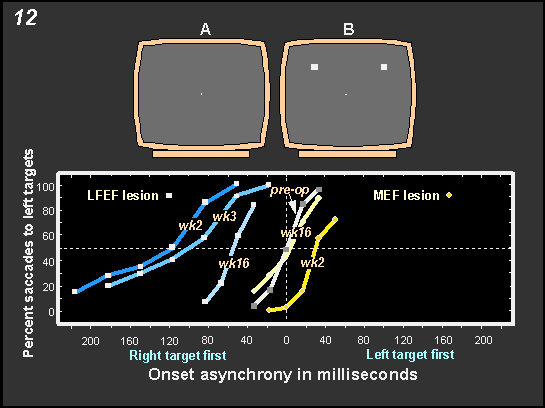The Neural
Control of Visually Guided Eye Movements
C. Cortical Mechanisms of Visually Guided Saccadic Eye Movements
 To
study target selection, paired targets were presented and monkeys had
to make saccadic eye movements to one or the other of the targets to be
rewarded. This is shown in the top of Figure
12. The temporal asynchrony with which the targets appeared
was varied randomly from trial to trial. Normal monkeys tend to select
the left and right targets with equal probability when they appear simultaneously.
Unilateral removal of the frontal eye fields causes a major, long-lasting
deficit in target selection; the target appearing in the contralateral
hemifield has to be presented much earlier than the other target to yield
equal probability choices. By contrast, removal of the medial eye fields
has only a minor effect on target choice and the execution of sequences
of eye movements. To
study target selection, paired targets were presented and monkeys had
to make saccadic eye movements to one or the other of the targets to be
rewarded. This is shown in the top of Figure
12. The temporal asynchrony with which the targets appeared
was varied randomly from trial to trial. Normal monkeys tend to select
the left and right targets with equal probability when they appear simultaneously.
Unilateral removal of the frontal eye fields causes a major, long-lasting
deficit in target selection; the target appearing in the contralateral
hemifield has to be presented much earlier than the other target to yield
equal probability choices. By contrast, removal of the medial eye fields
has only a minor effect on target choice and the execution of sequences
of eye movements.
|